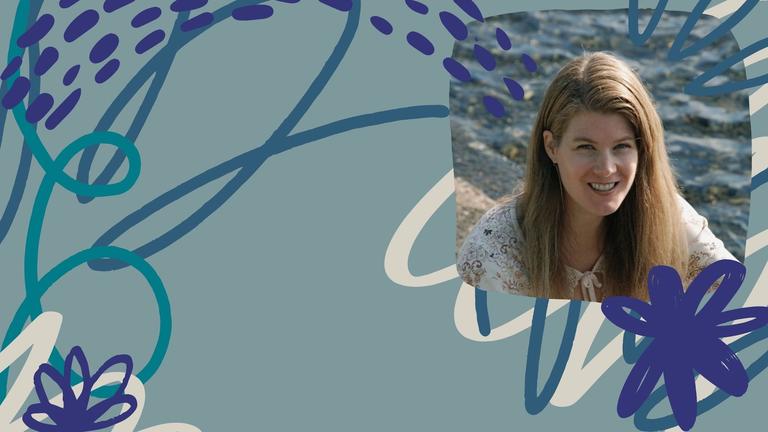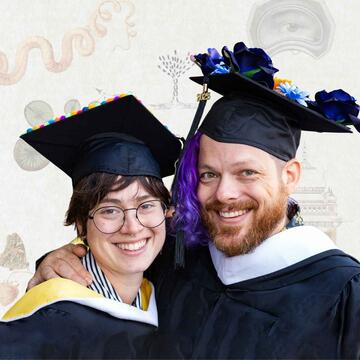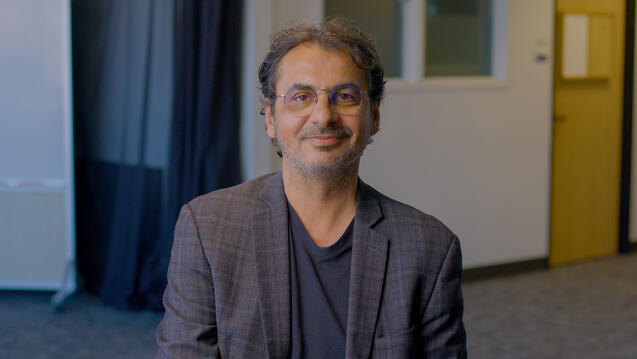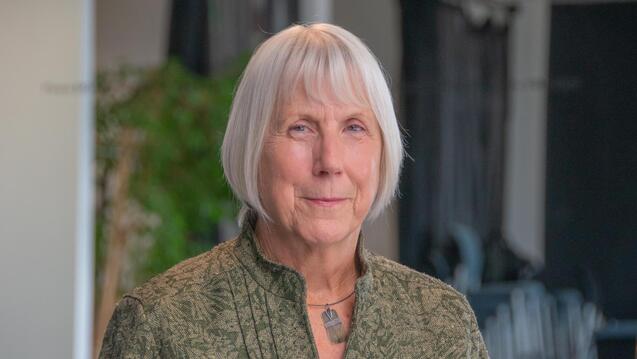Senior Lecturer Cosmin Gheorghe shares how CIIS' Bachelor of Science in Psychology helps students connect disciplines and find meaning in a fragmented world.

Dreaming with Dr. Pearson Trimbach
New works from CIIS Professor of Clinical Psychology on the Psychological Potency of Dreams
Primary Process Impacts and Dreaming the Undreamable Object in the Work of Michael Eigen examines the work of psychologist and psychoanalyst Michael Eigen, and specifically his work on becoming a welcoming object. Curious about what that means? Well, CIIS’ own Professor Willow Pearson Trimbach has joined us to discuss the intersection of psychology, dreaming, and art as it relates to Michael Eigen and to her own work. Her chapter, “Welcoming Dreams,” won’t be available until June 2024, but she has graciously provided some advance insights for our community to explore.
Can you tell us a bit more about Michael Eigen and how you came to work with his ideas?
A professor of mine, Dr. Alan Kubler, first assigned a reading by Dr. Michael Eigen exploring Winnicott’s reflections on Primary Aloneness. I was struck. And I’ve been taken ever since by Eigen’s generosity of spirit, embodied in his scholarship (he has written more than 30 books), his teaching, his mentorship, and the community of scholar-practitioners creating an international mandala studying and furthering Eigen’s work.There are two volumes I have contributed to on the work of Michael Eigen. In a chapter entitled Elemental Contact [1], I wrote:
When I returned to graduate school in 2010, I happened to discover (or perhaps they discovered me) two seminal books from Eigen’s catalog. The first book was The Psychoanalytic Mystic (1998) and the second book was The Psychotic Core (1986). Having The Psychoanalytic Mystic and The Psychotic Core quietly take up residence on my bookshelf…provided a background support of which I was scarcely conscious. These volumes unsuspectingly extended the reach of my capacity to engage depth of spirit, on the one hand, and depth of psychopathology, on the other hand […]
Dr. Eigen’s work allows his reader to imagine and envision the psychoanalytic mystic who has a psychotic core and to see those two truths of madness and mysticism harbored within as genuinely confluent, and even generative, rather than as necessarily discordant or only as destructive. Dr. Eigen allows the reader to imagine herself as such a being—endowed with this human inheritance of psyche’s majesty and psyche’s catastrophe within her alike—and indeed allows the reader to regard psyche’s inheritance within all beings—as potential for contact with the depths in all their majesty and catastrophe. In this way, Dr. Eigen’s work allows the reader to become more fully human, more completely herself.
I know I am not alone when I underscore that Dr. Eigen’s work has been as transformative for me personally, emotionally, and clinically, as it has been catalytic for me intellectually and theoretically. I came to Dr. Eigen’s work at a time in my own life when I had a lot of integration work to do, and these paradoxical aspects of clinical work that he describes so brilliantly in his scholarship were as personally illuminating as they were professionally fascinating, for which I am very grateful. Through his work I was able to allow the disintegration to simply be, which was the beginning of integration in its own time. This simple truth was as compelling for me personally as it was captivating intellectually.
What was the process of writing this upcoming piece, Welcoming Dreams? What sustained you and helped you to develop it?
I think the essence of this piece was motivated, at its depths, by love. I think that love is at the root of most all creative expression, as an expression of love or as a longing for love or as a separation from love or as a revelation of love. Love may be buried or shining, but it is, I would venture, often at the very root. I was seeking to express my love for Eigen, my love for his scholarship and his teaching and his mentorship. I was seeking to express my love for my husband, drawing upon lyrics that I share in this chapter, from songs that my husband Daniel Trimbach and I wrote together, as a portal to love as ground and goal in both the personal and in the transpersonal sense (hear our songs here). I was seeking to express my love for dreams, the great conductors of spirit touching and messaging the soul. That love inspired me, compelled me, sustained me, and taught me in the writing and in the offering through publication.
A caesura, generally speaking, is a pause or break. Can you explain how you are using it in this specific context?
“Caesura—in its psychoanalytic context—is a selectively permeable membrane that simultaneously unites and separates that which it links.”[2] I go on to describe the practice of Dreaming the Caesura, which is an Integral Relational method of nonduality.
What draws you to incorporate dreaming into your personal and academic practice?
My first languages are dreaming and singing. They are like cojoined twins (to adopt an expression that the late psychoanalyst James Grotstein would often use, denoting the confluence of separation and union). Dreaming is primary. It is the language of divinity, encrypted. Singing is like a decryption of that primary language which is, at the same time and on another level (to use another Grotsteinism), yet another encryption of the soul, through poetry and music. For me, dreaming and singing are languages of truth, however hidden or camouflaged. The practice of decryption is listening, through the emotional intelligence of a soul to soul link, unconscious to unconscious communication (consciousness that moves between beings) that can be inflected, in grace notes, in our personal consciousness.
Is there anything you can recommend for readers who may also want to examine dreaming more deeply for their own work?
I highly recommend writing down your own dream images, upon waking, or simply jotting down a dream image from waking life, and re-reading it, associating to it, and giving it expression — whether telling it to a trusted dear one, creating art from the image — bringing the voice of spirit into soul through this simple and meaningful act. In this way, through this practice of regarding our dreams, we live by our embodied-spirit-in-the-world. Even, and perhaps especially, when dreams are nightmares, this process is worthwhile…but that is another related conversation…
What do you hope readers take from your work?
I hope readers will listen to their dreams from a place of curiosity and wonder that keeps opening. I hope the voice that says, “what a strange dream” might be gentled to consider “this dream—what a wonder…” and allow wonder, through listening to y/our soul’s encryption, to unfold…
--
You can read more of Prof. Pearson Trimbach’s recent work here:
[1] Pearson, W. (2021). Elemental contact: From madness to mysticism. Celebrating the work of Michael Eigen. In K. Cohen and K. Fuchsman (Eds.) Healing, Rebirth and the Work of Michael Eigen: Collected Essays on a Pioneer in Psychoanalysis. Routledge.
[2] Pearson Trimbach, W. (2022). Integral relational practice of dreaming the caesura. Part 1: Opening further through the spiritual psyche. Part 2: Dreaming Charlotte Small Thompson. Jung Journal: Culture & Psyche, 16(4).

Clinical Psychology
Guided by a vision of psychotherapeutic clinical practice that emphasizes holism, depth, and difference
Related News
Professor Jeanine Canty explores how the Transformative Studies Ph.D. prepares visionary changemakers to address humanity's disconnection from nature and each other.
Dr. Janis Phelps founded the world's first academically approved psychedelic therapy training program, preparing clinicians for a transforming field of mental health.



